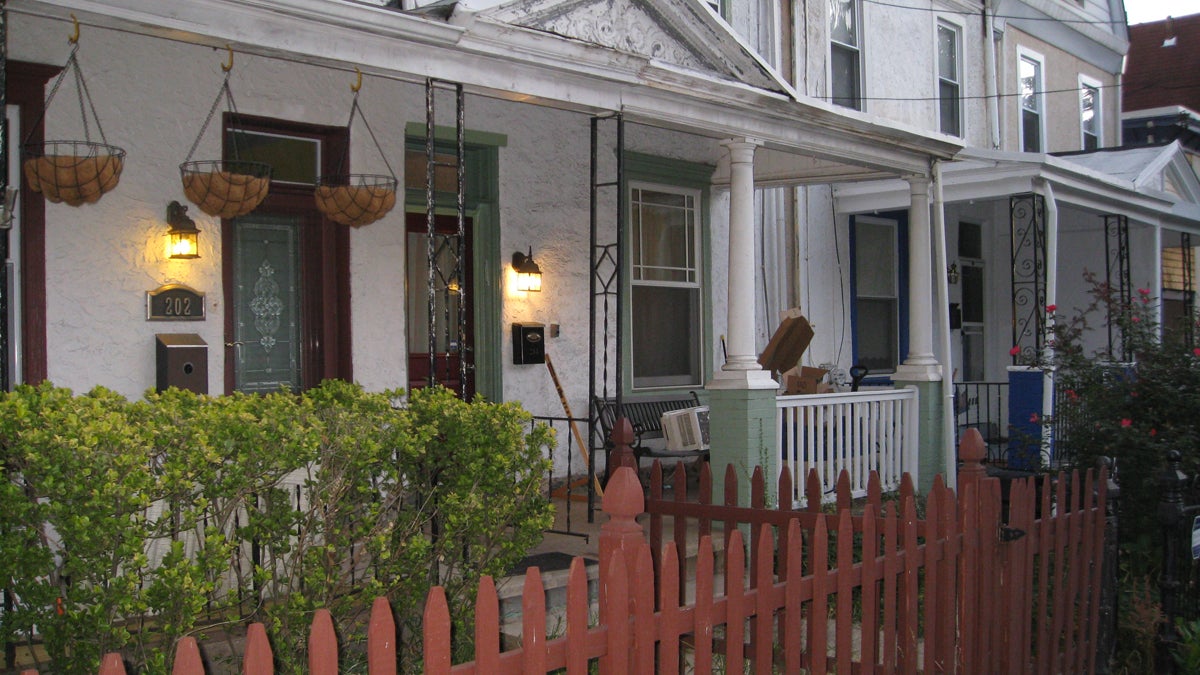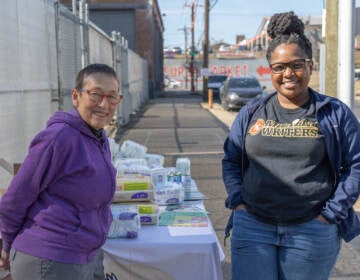Love thy neighbors — because you can’t divorce them
Listen
Th author's Mt. Airy block (Anndee Hochman/for NewsWorks)
We knew the neighbors had become true friends when they came to help us say goodbye to the old refrigerator.
Here’s the story: My mother hates change. Her living room has had the same red wall-to-wall carpet for 50 years. She kept her platform shoes until they cycled back into style. And when the three-compartment, built-in refrigerator finally sputtered to a stop, we held a ritual to mark its passing.
The family across the street — a 40-something couple with a bright, sweet son a few years older than my daughter — had been over for dinner once or twice, and my partner and I had happily joined the group. We zipped the kids into footed pajamas so they could watch Once Upon a Mattress on my parents’ VCR (that’s right: a VCR) while we ate dessert.
Maxine, Steve and their precocious Elliot were just the latest in a long skein of neighbors who had laced themselves into our lives. In 1965, the block was crammed with young families whose kids were my constant playmates: the boy who dared me to touch my eyeball; the sisters who taught me Chinese jump rope.
It was the neighbors whose couch I slept on the night my mother and I came home to find the television by the front door and strange voices upstairs.
Neighbors — sometimes Harold on the left, or Izzy and Rose on the right — cased the living room and den with me when I was an anxious latchkey kid, afraid to enter the house alone.
And this year, when my father became ill and spent nine weeks in the ICU, the neighbors bundled my mother’s mail, made sure her walk stayed clear of snow, and drove to the hospital with fruit salad and homemade cake.
Strangers among us
Apparently, all this neighborliness is more the exception than the rule.
According to data from the 2014 General Social Survey, only about 20 percent of Americans spend time regularly with the people living next to them, and a third say they’ve never interacted with their neighbors. That’s a sharp drop from four decades ago, when a third of Americans hung out with their neighbors at least twice a week.
And what are we doing with the time we used to spend at backyard barbecues or coffee klatches with the folks next door? In part, connecting with farther-flung loved ones (and complete strangers) through Skype, Facebook and e-mail.
More and more, we conduct our lives at arm’s length. I text my best friend, even though she lives two blocks away. Sometimes my daughter telephones — she’s in her bedroom; we’re in the kitchen — to ask what we’re having for dinner. I chat with my aunt, Bluetooth receiver plugged into my right ear, while driving to pick up the kids from school.
Neighbors, on the other hand, are in your face. Or at least, across your walkway, driving you insane with that leaf-blower or offering you the last of the green tomatoes before they freeze. They’re the people you didn’t choose to have in your life; they’re the ones you can’t divorce.
Depending on how snugly you’re situated, a strange intimacy can flower. You smell the neighbors’ curry every time you pass apartment 4G. They hear your argument through the open kitchen window. You figure they got a new TV because the clunky old Sony is out by the curb. They know you’re away because newspapers pile up on the porch.
Proximity doesn’t always breed affection. But sometimes, against all odds, it does. You start to care about Miss Dottie, who carpets her patio each spring in brand-new wall-to-wall Astroturf. You bring some jam to the guys across the street, the ones with the tiki room plastered in 1960s kitsch.
One day, you find yourself bonding with the ladies two doors down — even though they are African-American Seventh Day Adventists and you are white Jewish lesbians — over the troublesome neighbors in-between, the ones with out-of-control bamboo and shifty eyes.
Not every neighbor is destined to be your friend. I’ve lived next door to a crack house (Portland, Oregon) and a bunch of 20-something squatters (right here in beautiful Mt. Airy). My in-laws were plagued for years in their five-unit Denver condo by a tyrannical neighbor who policed the laundry-room schedule and blasted rodeo music late at night.
But most people aren’t like that. Most people are no stranger than you are — yes, you, with your habit of greeting the UPS guy in your ratty college bathrobe or belting songs from Pippin while you wash the car.
Just a door-knock away
If you believe — and I do — that reconciliation is within reach between whites and blacks in South Africa, between Protestants and Catholics in Northern Ireland, even between Israelis and Palestinians in the bloodied Middle East, then how can you not make an effort to co-exist amenably with the people on your own block?
So start small. Tap on the neighbor’s door. Borrow a cup of sugar; bring back a plate of cookies. Share the lawnmower, because who really needs her very own? Break that paste-thick silence in the elevator and discover that the guy in bike shorts lives just below you. He adores country music while you love Pavarotti; laugh about the dissonant duet when you both crank your iPods on Sunday afternoons.
Then take a few giant steps back, far enough to remember that we’re all neighbors on this dizzied, fragile knob of earth. Think about the fences we raise to keep ourselves apart — border crossings, Berlin Walls — and the conversations that might, just might, knit us together.
In the end, of course, our odd ritual wasn’t about the refrigerator. It was about change — resisting it, yielding to it, marking it. We stood in a semicircle — me, my partner, my daughter, my parents and the trio from across the street — and I thought about all the neighbors who had shared food from that fridge or eaten at our table: the people we didn’t plan to love, the ones who are just a slender wall away, passing in and out of this brief, sweet life.
WHYY is your source for fact-based, in-depth journalism and information. As a nonprofit organization, we rely on financial support from readers like you. Please give today.




